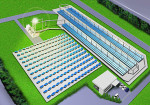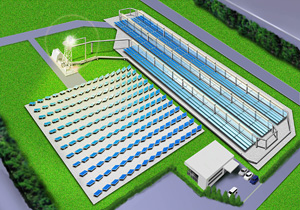Mitsubishi Hitachi Power Systems has received order concentrating solar power system from Japanese Gov.

BHK Selected by Ministry of Environment to Develop CSP Technology – Targeting Establishment of Low-cost, Highly Operational System –
Date: Sep 26, 2014
Source: Mitsubishi Hitachi Power Systems, Ltd.
Yokohama, September 26, 2014 — Babcock-Hitachi K.K. (BHK), a group company of Mitsubishi Hitachi Power Systems, Ltd. (MHPS), has been contracted by Ministry of the Environment to develop the technology for a concentrating solar power (CSP) system as one of its 2014 projects to develop and verify technologies for enhancing measures to reduce carbon dioxide (CO2) emissions. The contract calls for BHK to develop a low-cost, highly operational solar power generation system. MHPS will also participate, and after the two companies integrate effective October 1, MHPS will carry on the contracted work in full.

Conceptual image of the verification facility of HSTS solar thermal collecting system
CSP is a system in which a large area of sunlight is focused on a small area in order to generate high-temperature steam which is used to drive a steam turbine, to generate power (Note 1). The cost factor is critical to the achievement of a viable system, and under the contracted project BHK and MHPS will target the development and verification of a low-cost solar thermal collecting system — key to overcoming the cost impediment — as well as development of optimal technology for the total system with power generation equipment, including element verification of the high-temperature heat storage system. The period will be three years. Plans call for a verification facility for the low-cost solar thermal collecting system to be constructed at MHPS’s Yokohama Works (Honmoku Area), with commencement of test operation of the new system slated for 2016.
CSP offers a number of advantages over photovoltaic power generation: less fluctuation in power output vis-à-vis fluctuations in solar radiation intensity, and stable power supply even under cloudy or nighttime conditions by storing collected heat when available. Remaining challenges needing to be overcome are the complexity of the CSP system itself and the relatively higher cost of power generation compared to more conventional solar systems. In response to these challenges, BHK has devised proprietary technology for a low-cost hybrid solar tower system (HSTS) (Note 2) that combines a low-temperature Fresnel evaporator and a compact tower-type superheater.
Through this project MHPS and BHK will undertake the development of a system combining HSTS technology and high-temperature heat storage technology, aiming for the establishment of CSP technology offering the advantages of low cost and superior operability.
(Note 1) CSP systems of various types exist; the type described here is the most prevalent system commercialized outside Japan.
(Note 2) Hybrid Solar Tower System utilizes a Fresnel type solar collector through the water evaporation stage, and subsequent saturated steam heating is performed by concentrating sunlight on to a receiver in the small tower’s upper section with heliostats.










Japanese firm to build solar thermal power plant
Date: Sep. 25, 2014
Source: NHK World
A Japanese company plans to develop an improved method of solar thermal power generation, or using sunlight to create steam for driving turbines. The heat can be stored and used to generate electricity at night or on cloudy days.
Mitsubishi Heavy Industries and Hitachi established Mitsubishi Hitachi Power Systems in Yokohama in February by integrating their thermal power generation divisions. The firm says it will build a solar thermal power plant at its factory in Yokohama and will begin test runs in 2016.
Solar thermal power is considered a more stable source of electricity than solar panels or wind turbines. But the facilities are expensive to build and are not very efficient. The company plans to develop a more effective method of solar thermal power generation to reduce costs.